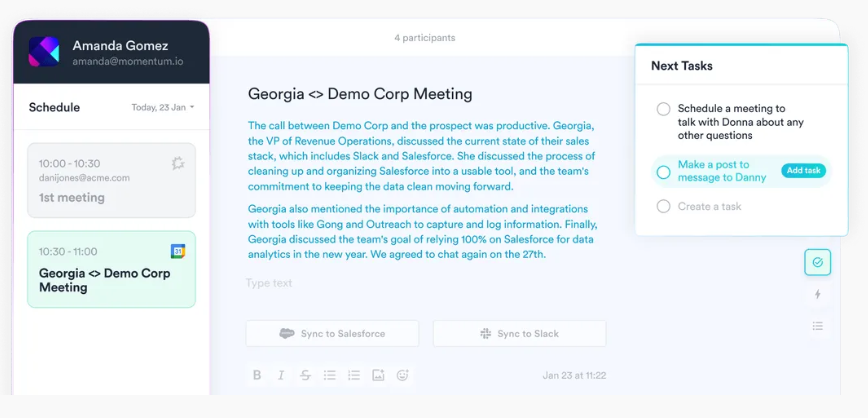If you’ve ever worked in a call-heavy environment, you know the toughest part isn’t taking the calls, it’s keeping track of what was said afterward. Sales reps, support specialists, and customer success teams spend hours summarizing conversations, jotting down notes, and updating CRMs. Over time, it becomes a tedious task that eats away at productivity. That’s why teams are turning to AI call summary tools to handle this growing workload.
This blog looks at how AI helps call teams work faster, maintain consistency, and focus more on meaningful conversations instead of manual documentation.
The Growing Pressure on High-Volume Call Teams
When calls keep coming in back-to-back, staying organized becomes a challenge. Every conversation has important details such as client expectations, follow-up actions, and verbal agreements that must be recorded accurately.
The information overload problem
High-performing sales and support teams often handle hundreds of calls daily. Keeping track of them manually is overwhelming, and even the most diligent note-taker can miss key points. Important details get buried in long recordings or forgotten altogether. The result? Miscommunication, delays in follow-ups, and frustrated customers.
AI tools help reduce this problem by automatically listening, transcribing, and summarizing every call. Instead of skimming through recordings later, you get an instant, concise summary that captures what actually matters.
Time lost to administrative work
Manual note-taking is more than a small inconvenience, but it’s a drain on valuable time. After each call, team members might spend 10–15 minutes writing notes or updating CRMs. Multiply that across a day’s worth of calls, and it quickly adds up to hours of administrative work.
This time could be spent nurturing leads, closing deals, or solving customer problems. By removing the burden of after-call tasks, AI gives teams the breathing room they need to focus on their core responsibilities, connecting with people and building relationships.
How AI Call Summary Changes the Workflow
Modern AI tools go beyond transcription; they understand context, tone, and intent. They’re not replacing human effort but helping you manage communication better.
Instant transcription and intelligent insights
An AI call summary tool listens to calls and turns them into structured notes in seconds. It identifies key topics, questions, and next steps. Some even detect emotional cues or patterns, showing where customers express hesitation or satisfaction.
These summaries can include action items, such as “send proposal,” “schedule follow-up,” or “update contract terms.” Instead of sifting through pages of transcripts, your team gets a clean, actionable overview. It’s like having an assistant who captures the essence of every call without missing a thing.
Reducing cognitive load
When you don’t have to take notes mid-conversation, your attention stays where it belongs, on the person you’re speaking with. You can listen more actively, respond thoughtfully, and build a stronger rapport.
AI also makes collaboration easier. Summaries can be shared instantly across departments so that everyone, from sales to support, knows what was discussed. There’s no confusion, no gaps in information, and no need to repeat updates.
Speed meets consistency
Manual summaries vary depending on who writes them. Some are detailed; others are vague. AI brings uniformity to this process. Every call is summarized using the same structure, which helps teams compare data, track progress, and evaluate trends.
This consistency helps during performance reviews or training sessions, too. Managers can easily analyze summaries to spot communication gaps or recurring customer concerns.
Integrating AI Summaries into Team Workflows
For AI summaries to make a real difference, they need to fit smoothly into your team’s daily routine.
Syncing with CRM and communication tools
The best systems integrate directly with your CRM or communication platforms. This means every summary, key point, and follow-up gets logged automatically; no manual updates are required. Your data stays organized, searchable, and easy to reference later.
Centralized information also prevents errors. Everyone can access the same set of notes, so there’s no confusion about what was promised or discussed. This saves your team from awkward mix-ups and helps maintain consistency across client touchpoints.
Training teams to trust automation
When you introduce AI into your process, some hesitation is normal. People may worry about accuracy or losing control over how their work is represented. The best approach is to treat AI summaries as a partner, not a replacement.
Encourage your team to review the first few summaries and make small corrections if needed. Over time, the system learns and improves. Once team members see how much time they save, trust builds naturally.
Conclusion
The future of AI call summary tools goes far beyond transcription. Soon, these systems will analyze tone, suggest follow-up timing, and even predict when a customer might be ready to re-engage. But the real value will still come from how you use that information.
AI can capture words and organize thoughts, but your interpretation turns those insights into action. Teams that learn to balance automation with human intuition will move faster and communicate better. When machines handle the routine, you gain time for what actually matters.



